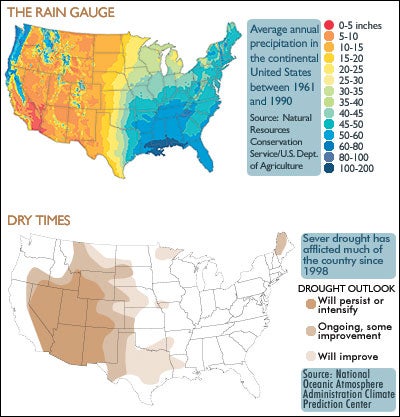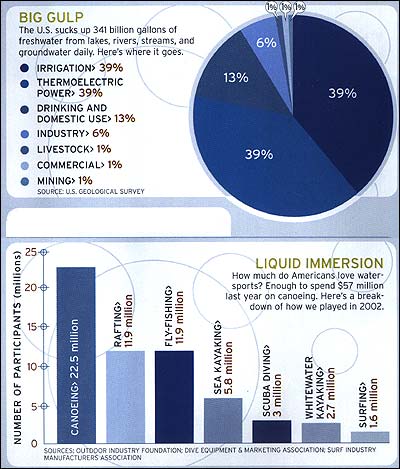Indirect, Invisible, and Insidious
All About H2O
The wet stuff is always there for usit grows our food, puts splash and spirit in our adventure, and (by the way) keeps us alive. for a special report on the health of America’s most vital resource.WATER CANON.
for a complete list of ���ϳԹ���‘s articles on American water, from William T. Vollmann’s filthy Salton Sea journey to the new hero of the Mississippi.
Water pollution is more complicated than ever. That leak in your oil tank, the bug juice you spray on your garden, the soap you use to scrub your boatall this and more pollute aquatic ecosystems, and ultimately the drinking water pouring from your faucet. Storm-water runoff from lawns, streets, piers, and parking lots washes into approximately 5,000 square miles of estuaries, 2,200 square miles of lakes, and 30,000 miles of rivers in the United States, lacing them with pesticides, hydrocarbons, and heavy metals. Then there’s auto exhaust: American car and truck drivers produce 8.2 million tons of nitrogen oxide per year, all of which returns to the earthalong with the 1.9 billion pounds of pollutants that spew out of industrial smokestacks annuallyas precipitation, through a process called atmospheric deposition. This means that little is left untainted, from the mercury-poisoned Great Lakes basin to the Appalachian Mountains, whose slopes are being denuded by acid rain.
Wetlands Get Whacked
Wetlands support a huge, interdependent network of plant and animal life, clean and recharge groundwater, and moderate the climate by returning H2O to the atmosphere. Still, since the 1700s, we’ve managed to eliminate more than half of all wetlands in the lower 48; only 100 million acres remain. The stats are grim: California has lost more than 90 percent of its original wetlands, Florida more than 50 percent. The greatest loss has occurred in the Louisiana bayou, which once stretched nearly 300 miles into the Gulf of Mexico. Due to erosion, urban development, oil and gas drilling, and silt diversion from levees and canals on the Mississippi River, as many as 35 square miles of bayou disappear underwater annually. Without healthy marshes to protect it from hurricanesa storm surge is diminished by a foot for every 1.5 miles of wetlands it crossesNew Orleans could experience 25,000 to 100,000 casualties if hit by a Category 5 hurricane.
High and Dry vs. Dripping Wet

Know Your Toxins
They’re out there, drip-drip-dripping into the water you drink
| WHAT >> | WHERE >> | DANGER >> |
| PERCHLORATE: A salt ion, similar to nitrate, used in solid rocket fuel, explosives, fireworks, and car air bags | The EPA has found 75 releases in 22 states but has yet to settle on a safe level for U.S. drinking water | Disrupts the thyroid gland, which can cause developmental damage in fetuses and newborns, as well as tumors in adults |
| DIOXIN: A by-product of chlorine-based chemicals and hydrocarbons | Wherever chlorine compounds are burned: waste incineration; electrical plants; chemical and pesticide manufacturing | Testicular and prostate cancer, immune-system damage, reproductive disorders |
| MTBE: Methyl tertiary butyl ether, a gas additive that was developed to clean auto exhaust | In 500 public drinking-water wells and 45,000 private wells across 49 states | Known carcinogen in large doses; extremely difficult to clean up |
| HEAVY METALS: Mercury, lead, copper, cadmium, arsenic, selenium, nickel, chromium | Everywhere! Soil, rock, aquifers, electrical equipment, paint, auto exhaust, anything with a smokestack | Hepatitis, circulatory collapse, hypertension, neurotoxicity—you name it, they cause it |
| ATRAZINE: One of the most widely used herbicides in the United States. | Seventy-seven million pounds sprayed on American crops annually; banned in parts of Europe | A 2002 study suggests it may cause sexual deformities in frogs; the EPA has flip-flopped on whether it is a “likely human carcinogen” |
| PCBs: Polychlorinated biphenyls—a stew of up to 209 chemicals, used in the electrical industry as lubricants and coolants | Outlawed in 1977, spilled and dumped extensively before then (see Hudson River, Palos Verdes Shelf, and Great Lakes) | Skin rashes, neurobehavioral and immunological problems, possible liver damage in humans; anemia, thyroid disease, cancer in animals |
Big Gulp and Liquid Immersion
